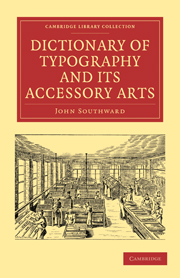Summary
JEFFING.—Throwing with quads. The plan adopted is to take nine em quads–Long Primer being mostly chosen; these are laid on the imposing surface for the inspection of the whole of the party interested in the matter at issue. One of them takes up the quads, shakes them up between his two closed hands, and throws them on the imposing surface, after the manner of throwing dice, when the number of quads with the nicks appearing uppermost are counted, each person having three throws (raffle-fashion), the highest thrower being the winner, or taking his choice of any “fat.” This performance is not so much in vogue now as it was years ago, before the “clicking” system came up; then it used to be of daily occurrence in the composing-room, when the title, index, blanks, tables, &c, of a work were given in hand, for the compositors to throw who should have the best choice of the “fat.” The title-sheet was divided into lots, say: 1, title and blank; 2, preface; 3, dedication and blank; and so on, according to the prefatory matter introduced into the work. Words of Greek, for which one shilling per sheet is charged, were also “thrown for;” but the clicking system does away with all that, by making a general bill; so that each of the companionship comes in for a proportionate share of “fat” as well as “lean.”
- Type
- Chapter
- Information
- Dictionary of Typography and its Accessory Arts , pp. 58 - 62Publisher: Cambridge University PressPrint publication year: 2010First published in: 1875



